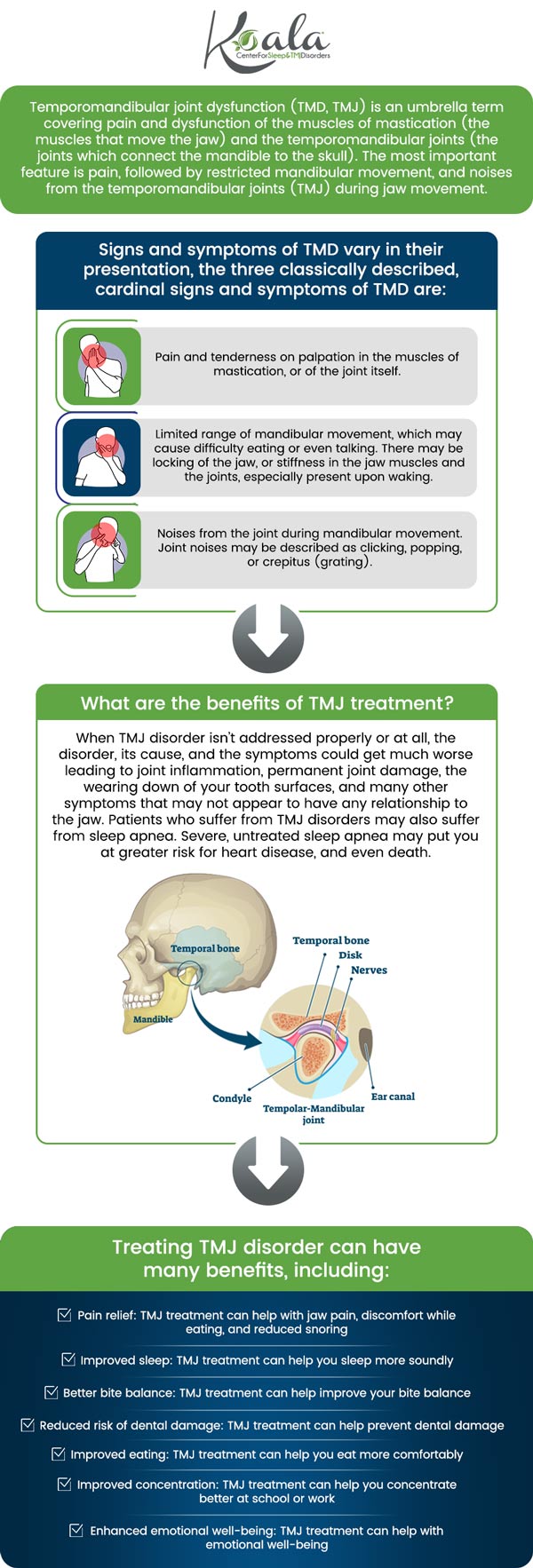How to Get Rid of TMJ Ear Fullness
TMJ ear fullness is often caused by dysfunction in the temporomandibular joint, which can lead to pressure and discomfort in the ear area. At Koala® Center for Sleep & TMJ Disorders, we offer effective treatments, including physical therapy, oral appliances, and exercises to help relieve TMJ-related ear fullness. Consult with our specialists to find the right approach for managing and alleviating the pressure in your ears caused by TMJ. For more information, please contact us today or request an appointment online. We have convenient locations in Bloomington IL, Peoria/Dunlap IL, El Paso TX, and Wausau WI.


Table of Contents:
What are the symptoms of TMJ ear fullness?
Can TMJ cause a feeling of pressure in the ear?
How is TMJ ear fullness different from an ear infection?
Can TMJ ear fullness be treated without surgery?
TMJ ear fullness is a common symptom among patients who are experiencing temporomandibular joint (TMJ) disorders. It is often described as a sensation of pressure or fullness in one or both ears. This discomfort can occur alongside other TMJ-related symptoms, such as jaw pain, clicking, popping sounds when moving the jaw, and more. The fullness might present as either intermittent or constant, and some individuals also report a muffled hearing sensation. Along with this feeling of fullness, the individual may experience discomfort occurring around the jaw, face, and neck, as the TMJ dysfunction can lead to muscle tension and misalignment that affects the surrounding structures. The feeling may worsen with activities that involve extensive jaw movement, such as chewing or speaking.
Ear fullness is often the result of the close anatomical relationship between the TMJ and the muscles that surround the ear. Dysfunction in the jaw joint can directly affect the ear structures, causing a sensation of fullness or pressure that might feel similar to an ear infection. However, the underlying cause is rooted in the TMJ, rather than an issue within the ear itself. For individuals experiencing persistent or frequent ear fullness related to TMJ, proper evaluation and treatment can help address both the jaw issues and the associated ear discomfort.
TMJ can cause a feeling of pressure in the ear. The temporomandibular joint (TMJ) is positioned near the ear, and when it becomes dysfunctional, the muscles surrounding it can become tight or misaligned, leading to sensations of pressure or fullness. This feeling may not always be localized to just one ear and can affect both ears, depending on the severity of the TMJ disorder. The pressure may fluctuate throughout the day, sometimes intensifying with activities that involve movement of the jaw, such as chewing, yawning, or speaking. This discomfort can be particularly troublesome as it mimics symptoms of ear infections or other ear-related conditions, often leading to confusion about the source of the problem. Treatments that are aimed at relaxing the jaw muscles and improving jaw alignment can often help reduce or eliminate the sensation of pressure in the ears, providing significant relief for those suffering from these symptoms.
TMJ ear fullness and an ear infection may present with similar symptoms, such as a feeling of pressure in the ear, but they differ in a number of ways. Ear infections are typically associated with inflammation or infection in the middle or outer ear, often accompanied by additional symptoms like fever, drainage from the ear, or significant pain within the ear itself. TMJ-related ear fullness is primarily due to jaw dysfunction that causes pressure around the jaw, which can affect the nearby ear structures. While the discomfort can feel similar, TMJ ear fullness is not associated with an infection, and it is often accompanied by other TMJ symptoms such as jaw pain, clicking, or difficulty opening and closing the mouth.
The main distinction between the two is the source of the discomfort. An ear infection typically requires medical attention to address the infection and alleviate symptoms, while TMJ-related ear fullness is a result of the dysfunction in the temporomandibular joint. For individuals dealing with persistent ear fullness that does not improve with conventional ear treatments, seeking evaluation from a TMJ specialist at Koala® Center for Sleep & TMJ Disorders is required for proper diagnosis and effective relief.
TMJ ear fullness can often be treated without surgery. Most cases of TMJ-related ear fullness respond well to non-surgical treatments that focus on relieving the tension and misalignment of the temporomandibular joint. Common treatments include physical therapy, jaw exercises, and the use of oral appliances, such as nightguards, which help reduce the strain on the jaw muscles. The goal of these treatments is to help to relieve muscle tension, realign the jaw, and promote proper function, which can significantly reduce or eliminate the sensation of ear fullness. Additionally, lifestyle modifications, such as reducing stress and avoiding excessive jaw movement, can further support the healing process. The specialists at Koala® Center for Sleep & TMJ Disorders often recommend a comprehensive treatment approach that addresses both the jaw and the associated ear symptoms.

Additional Services You May Need
▸ KoalaKIDZzz®
▸ Sleep Apnea
▸ Snoring
▸ TMJ Disorder
▸ Fatigue
▸ Sleep Disorders
▸ Weight Loss
▸ CPAP Alternative
▸ Oral Appliances




